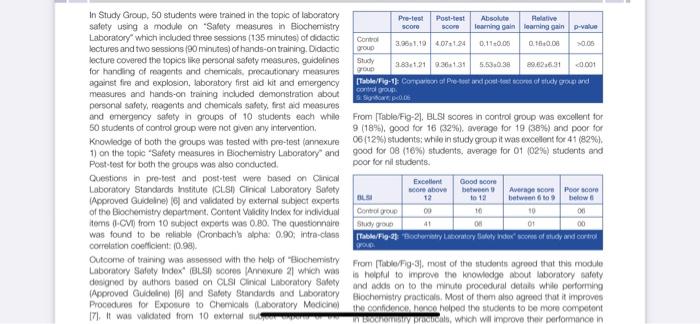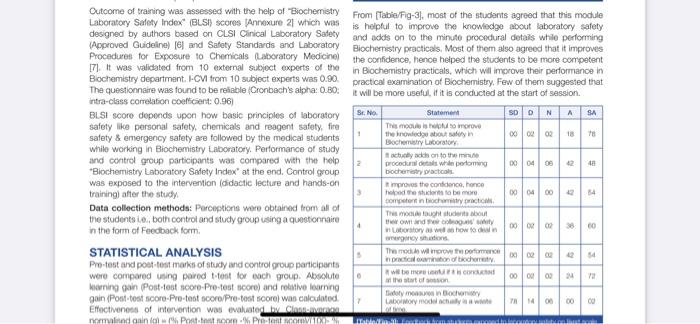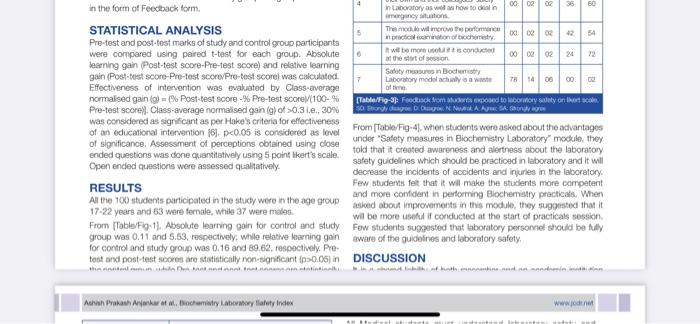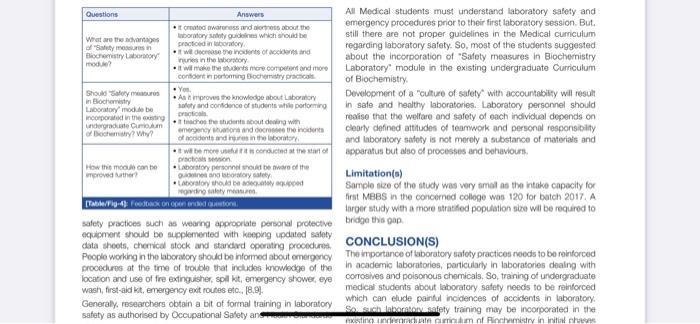Biochemistry
Safety Measures in Biochemistry Section Laboratory: Need of the Hour
9. Review the tests and valuation methods used in the study. Do you think they were suitable? Explain your answer
10. Propose and justify other valucus alternatives that could be used in this study.
INTRODUCTION MATERIALS AND METHODS Laboratory ervironment can be hazardous place to woek. A prospective interventional study was conducted from Soptember Biochemistry laboratories like any other Chemistry laboratory 2017 to March 2018, Institutional Ethics Committee Clearance for contain certain inherent dangers and hazards. Al the the study was obtained IEC Letter of Approval Ret, No. DMilMS undergraduate students of MBBS have to perform practicals (DUMEC/2017-18/6914 Date; 16/12/2017), Witten consent in the Biochemistry laboratory throughout the first year MEBS, was obtained from all the students. The study population was They routinely come in contact with chemicals, reagents, undergraduate madical students (1" semester MaBS students). A fre and biological samples in the laboratory. Catastrophic total of 120 students in whole 2017 batch MBES were included accidents occurred in the academic laboratories have drawn the and ou of them only 100 could participate in alf the activales of consideration of authorities and media and thus, have highlighted the study. Data obtained from romairing 20 students (10 from. the importance of guidance and implementation of laboratory Study group and 10 from control group) were discarded as they safety in the academic settings [1-5]. Therefore, all the medical did not attended al the sessicns of the training. The response rate students should learn to work safely in laboratceies in order to was 83.33%. Out of 100 students who participated in this study, prevent damage to everyone around. 50 (A batch) categorised as study group, whereas other 50 (B batch) It is pivotal to develop pure safety culture in research and teaching were categorised as control group, randomly. This grouping was. lobsatorios in the academie inatitutions. Medicat students must done using convervence samping. The students participating in this make a constant effort to think about the potential hazards. study were criented to the purpose of the study and motivated to associated with what they are doing and to thirk about how to work participate in the study. safely to prevent or minimise these hazards as much as possble Inclusion criteria for cases: The students who were present and [4), But, stil there are no proper guidelines in the Medical curriculum attended al the three sessicns (135 mimates) of didactic loctured regarding laboratory safety. So, skil training about Laboratory safety and two sessions (90 mirutes) of hands-on traing on "Salety in Blochemiatry laberatory will be usetul for the MEes students. All measures in Blochemistry Laboratory after Pre-test. Modical students must understand laboratory safety and emergency. Exclusion criteria for cases: The repenters wore excided from procedures prior to their first Laboratory session, So, this study was the study, due to lack of their regular attenciance. peiromed at Department of Bochemistry to train the undergraduate Inelusion criteria for controls: Control grove wore those students medical studens about laboratory salety ueing "Salety measures in who were not given ary intervention. In Study Group, 50 students were trained in the topic of laboratory salety using a module on "Saloty measures in Biochemistry Laboratory" which included three sessions (135 minutes) ot didactic lectures and two sessions {90 minuses) ot hands-on trairing. Didactio becture conered the lopics like personal salety measures, guideines for handing of reagents and chemicals, procautionary measures against fire and explosion, laboratory first aid tht and emergency measures and hands-on training included demonstration about personal safety, reagents and chemicals salety, frst aid moasures and emergency safety in groups of 10 students each whils From [TablerFig-2], BLSt scores in control group was excellent for 50 students of control group were not given any intervention. 9 (18\%), good for 16(32%), average for 19 (38:) and poor for Knowledge of both the groups was tested with pre-test lannexure 06 (12\%) students; while in study group it was excelent for 41 ( f82\%), 1) on the topic "Satety measures in Biochemistry Laboratory' and good for 08 (16\%) students, average for 01 (02\%6) students and Post-test for both the groups was also conducted. poor for nil students. Questions in pre-test and post-test were based on Clincal Laboratory Standards thsthtute (CLSi) Clnical Laboratory Sadoty (Approved Guideline) (6) and validated by external subipct experts of the Biochemistry department. Content Vaidity index for individual items (.CVi) from 10 subject experts was 0.80. The quostionnaire was found to be roliable iCronbach's ophe: 0.90; intre-class correlation coefficiant: (0.96). Cutcome of training was assessed with the holp of "Biochemistry From [Tablaffig-3), most of the Itudents agrood that this modile. Laboratory Salety index" (BLSI) scores (Anixaxure 2) wich was is heptul to improve the lonowedgo about laboratory salety. designed by authors based on CLSt Cinical Lnboratory Salety and adds on to the mimute procudural detals while pertorming. (Approved Guddelnel [ef and Soboty Standiods and Liboratory Biochemisiry practicais. Most of them also agreed that it improves Proceduees for Expoeure to Chemicals (Laboratory Modicinel the confidence hence helped the students to be more competent Outcome of training was assessed with the help of "Biochemistry From [Tabia/fig-3], most of the studants agreed that this module Laboratory Salety Index. (BLSi) scores JAnnoxure 2) which was is helptul to improve the knowedge about laboratory safety designed by authors based on CLSI Cinical Laboratory Satety and adds on to the minute procedural details while pertorming (Approved Guideline) [6] and Satety Standavds and Laboratory Biochernistry practicals, Most of them also agreod that it improves Procedures for Expeetre to Chemicals (Laboratory Medicinel the confidence, hence helped the students to be more corrpetent [7]. It was valicated from 10 external subjoct experts of the in Biochemistry practicals, which will improve their performance in Bochemistry departmant. K.CV trom 10 subject experts was 0.90. practical examination of Bochemistry. Few of them suggested that The questionnaire was found to be relable fronbech's aipha: Q.80: it will be more useful, if it is conducted at the start of session. intra-class correlation coefficient: 0.96 ) BLSt score deponds upon how basic principles of laboratory safety like personal safety, chernicals and reagent safety, fire safety \& emergency safety are followed by the medical students while working in Biochemistry Labcratory. Performance of study and control group participants was compared with the help "Biochemistry Laboratory Sadety Index" at the end. Control group was exposed to the intervertion (didactic lecture and hatwds-on training) after the study. Data collection methods: Perceptions wore obtained trom al of the students i.e., both control and study group using a queotionnaire in the form of Feectook form. STATISTICAL ANALYSIS Pre-test and poet-test marks of study and control group paricipants were compared using pared tetest for each group. Absolute kaenirg sain (Post-test score-Pre-test score) and rolative learning gain (Post-test soore-Pre-teot scoro/Pre-test soore) was caloulated. Effectiveness of intervention was evaluated be Clasifmemesa in the form of Feexback form. STATISTICAL ANALYSIS Pre-test and post-test marks of study and control group participants. were compared using pared t-test for each group. Absclute learning gain (Post-test score-Pre-lest score) and relathe learning gain (Post-test socro-Pre-test scorevpro-test score) was calculated. Effectheness of intervention was evaluated by Class-enverage nomalsed gain (g)= (\% Post-test soore -\% Pre-test score) (100% Pre-test score), Class-average normalised gain (gh of >0.3 i.e., 30% was considered as significant as per Hakes criteria for effectiveness of an educational intervention \{6], pe0.05 is considered as level of significance. Assessment of perceptions obtained using close ended questions was done quartitathely using 5 point thert's scale. Open ended questicns were assessed qualiathuly. RESULTS Al the 100 students participated in the study were in the age group 17.22 years and 63 were fernale, while 37 were males. From [TableFig-1), Absolute learring pain for conteol and study group was 0.11 and 5.53, respectively; while relathe lasaring gain for control and study group was 0.16 and 89.62, fespecthely. Pretost and post-test soorot are statistically non-significant (p>0.06) in All Medical students must understand laboratory salety and emergency procedures prior to their first laboratory session. But. still there are not proper guidelines in the Medical curriculum regarding laboratory safety. So, most of the students suggested about the incorporation of "Sadety measures in Biochemistry Laboratory" module in the existing undergraduate Curriculum of Biochemistry. Development of a "cuiture of safety" with accountability wil resulit in sate and henlthy laboratories. Laboratory personnel should redise that the welfare and safety of each individual depends on cearty defined attitudes of teamwork and personal responsibity and laboratory satoty is not merely a substance of materiats and apparatus but aso of processes and behavioun. Limitation(s) Sample nize of the atudy wes very amal as the intabe capecity for first MEBS in the concerned colloge was 120 for batch 2017. A larger study with a more stratiled population sibe wil be required to bridge this gap. safety practioes such as wearng appropriate personal protective equismert should be supplemented with keeping updited salety data sheots, chenvicd atock and standird oporating procodures. CONCLUSION(S) People working in the laboratory should be informed about emergency. The importance of laboratory salety practices needs to be roinforced procedume at the time of trouble that includes lenowbedge of the in academic laboratories, particularly in laboratories dealing with location and use of fre extinguisher, spil kt, emergency shower, eye corosives and poisonous chemicals, So, traning of undergraduate wash, first-aid kt, emergency ext routes etc. [8,9]. medical students about laboratory satety needs to be reinforced Generaly, researchers obtain a bit of formal trairing in laboratory which can elude paintul incidences of accidents in laboratory











